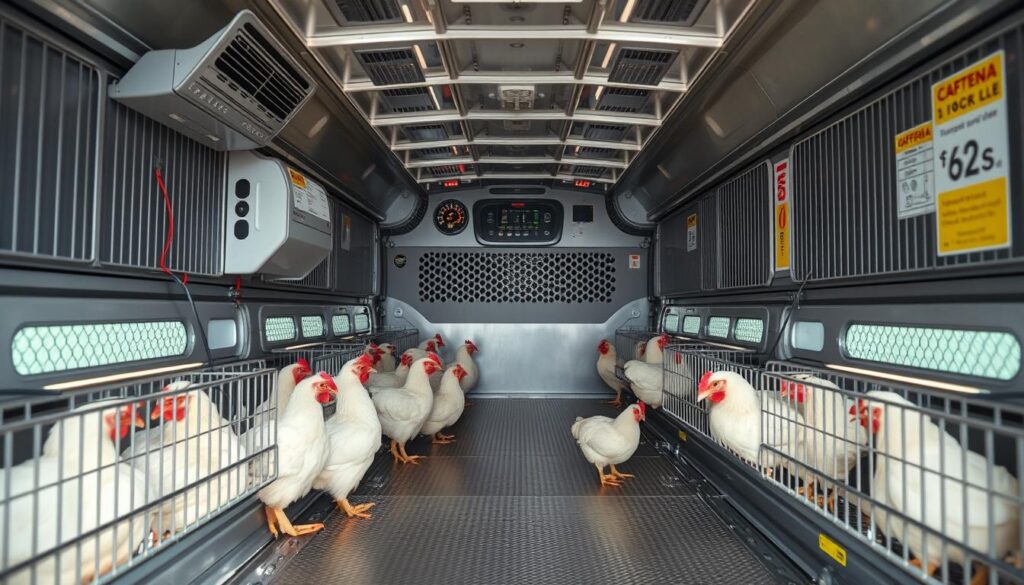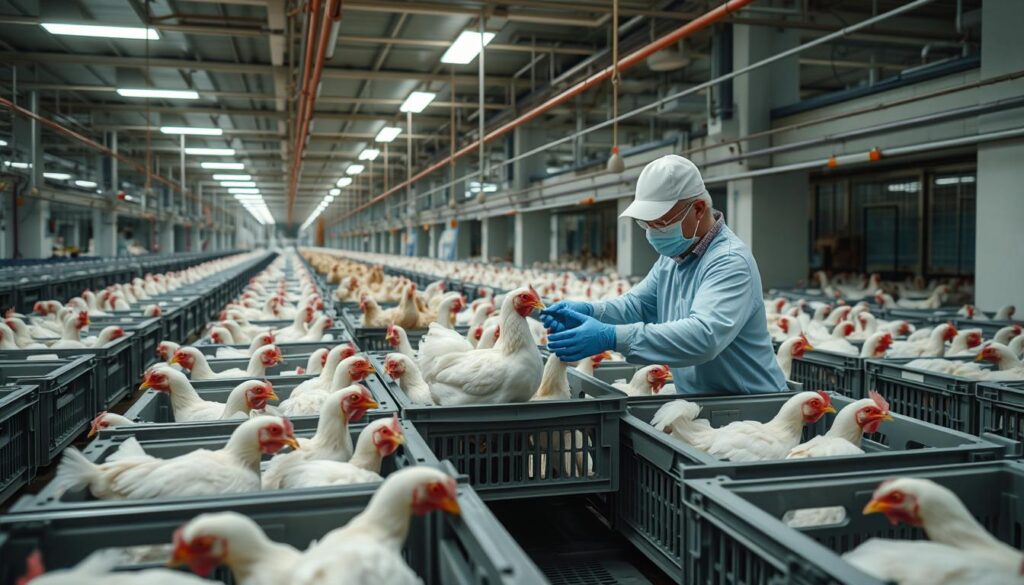
In today’s world, taking care of broiler chickens during handling and transport is very important. This article talks about the key things to consider, laws, and new ways to keep these birds safe. It also looks at how to keep food safe and protect the environment.
The humane handling and transportation of broiler chickens is a big challenge. It involves being kind, making money, and caring for the planet. By being kind to these birds, farmers can make better products and help the planet.
Key Takeaways
- Humane handling and transportation of broiler chickens are critical priorities in modern poultry production.
- Ethical considerations, economic benefits, and environmental sustainability are key drivers for implementing humane practices.
- Regulatory frameworks and industry standards guide the implementation of humane handling and transportation protocols.
- Emerging technologies and best practices offer innovative solutions to enhance broiler welfare throughout the supply chain.
- Ongoing training and education for poultry workers are essential for ensuring the consistent application of humane handling and transport methods.
Introduction: The Importance of Broiler Welfare
In the poultry industry, the welfare of broiler chickens is crucial. Ethical considerations have become key, as both consumers and industry leaders see the need to care for farm animals. Humane practices not only help the animals but also bring economic and environmental benefits for sustainable meat production.
Ethical Considerations in Poultry Production
The ethical treatment of broiler chickens is a key duty for poultry producers. Animal welfare standards must be met to ensure these birds live well without suffering. This not only does the right thing but also meets the growing demand for ethically sourced meat.
Economic and Environmental Benefits of Humane Practices
Using humane handling and transport for broiler chickens brings economic and environmental gains. It leads to better productivity, lower death rates, and better meat quality. Also, sustainable practices reduce waste, save resources, and help the environment.
“Adopting humane practices not only benefits the animals but also yields significant economic and environmental advantages for sustainable meat production.”
By focusing on broiler welfare, poultry producers can meet ethical, economic, and environmental goals. This helps the industry’s long-term success and reputation.
How to Ensure Humane Handling and Transportation of Broiler Chickens
It’s important to handle and transport broiler chickens humanely. This keeps them safe and meets animal welfare standards. It also helps follow food safety regulations. Everyone involved in the process must focus on the birds’ well-being.
Using gentle and quiet methods to catch broilers is key. They should be handled softly to avoid stress or harm. It’s also important to load them carefully to prevent overcrowding and ensure they always have water.
The transport vehicles play a big role too. They need good ventilation to keep the birds cool. The number of birds in the vehicle should be just right to avoid too much stress. Keeping the crates clean and disinfected helps prevent diseases.
| Best Practices for Humane Broiler Transportation | Benefits |
|---|---|
| Gentle catching methods | Reduced stress and injuries |
| Appropriate ventilation and temperature control | Prevent heat stress and mortality |
| Proper stocking density and crate design | Minimize overcrowding and ensure bird comfort |
| Continuous access to water | Maintain hydration and well-being |
| Thorough cleaning and disinfection of equipment | Enhance biosecurity and food safety |
Following these guidelines helps ensure broiler chickens are treated well. This improves animal welfare and makes the poultry industry more sustainable.
“Ensuring the well-being of broiler chickens during handling and transportation is not only the right thing to do, but it also has tangible benefits in terms of product quality, food safety, and consumer trust.”
Proper Catching and Loading Techniques
Handling broiler chickens with care is key to their well-being. It helps reduce stress and injury. Good handling practices are important for animal welfare and keeping farms safe.
Minimizing Stress and Injury
When catching chickens, it’s important to be gentle. Avoid sudden moves or loud sounds. Gently pick them up by the body or legs to move them safely.
- Use calming methods like dim lights or soft sounds to keep the chickens calm.
- Make sure the team knows how to handle the chickens right to avoid injuries.
- Give the chickens enough room and air in the crates to stay comfortable.
By focusing on the chickens’ welfare, producers help make the poultry industry better. This improves the birds’ lives and supports a more ethical industry.
| Proper Catching and Loading Techniques | Benefits |
|---|---|
| Gentle handling, avoiding sudden movements and loud noises | Minimizes stress and injury to broiler chickens |
| Trained catching team with knowledge of humane handling practices | Reduces the risk of injuries, such as broken bones or wing damage |
| Adequate space and ventilation in transportation crates | Ensures the birds can move and breathe comfortably, promoting their overall welfare |
“Proper catching and loading techniques are essential for maintaining the welfare of broiler chickens and ensuring a more humane and sustainable poultry industry.”
Transport Vehicle Requirements
Transporting broiler chickens needs special vehicles. These vehicles must keep the birds safe and healthy. They must meet strict standards to protect the chickens during their journey.
Temperature Control and Ventilation
Keeping the right temperature and air flow is key. Transport vehicles need advanced systems to control the environment. They should have air conditioning, fans, and vents to keep the birds cool and comfortable.
Biosecurity Measures
Biosecurity is very important when moving broiler chickens. Vehicles must be designed to prevent disease. They might have disinfectant footbaths, protective netting, and easy-to-clean surfaces.
Following these rules helps poultry producers keep chickens safe. It also helps with food safety regulations and environmental sustainability.

“Ensuring the wellbeing of broiler chickens during transport is not only an ethical imperative, but also a critical component in maintaining food safety and environmental sustainability.”
Regulatory Frameworks and Industry Standards
Ensuring the humane treatment of broiler chickens is key in the poultry industry. A strong system of rules and standards has been set up. These rules help keep animal welfare, food safety, and sustainable meat production high.
The USDA and FDA have made laws to protect broiler chickens at the federal level. These animal welfare regulations cover many areas. They include how chickens are handled, their living conditions, and their food. Poultry producers must follow these rules to stay in business.
The poultry industry also has its own industry standards that go beyond the law. These standards are set by industry groups or third-party groups. They focus on better treatment of broiler chickens and sustainable meat production. Producers who meet these standards can get certifications that show their commitment to animal welfare.
| Regulatory Framework | Key Requirements |
|---|---|
| USDA Poultry Products Inspection Act | Mandates humane handling and transport of broiler chickens, with strict guidelines on stocking density, ventilation, and temperature control. |
| FDA Food Safety Modernization Act (FSMA) | Establishes food safety regulations that impact poultry production, including measures to prevent contamination and ensure traceability. |
| Animal Welfare Approved (AWA) Certification | A voluntary industry standard that verifies adherence to high-welfare practices, such as access to natural behaviors and low-stress handling. |
By following these regulatory frameworks and industry standards, poultry producers show they care about ethics and sustainability. This gives consumers peace of mind that the meat they buy was made with care for the chickens.
Pre-Slaughter Handling and Lairage
In the poultry industry, treating broiler chickens humanely before slaughter is key. This stage, called pre-slaughter handling and lairage, manages chickens from transport to the processing area. It’s a critical time for animal welfare and ethical meat production.
Good pre-slaughter handling boosts chicken well-being and meat quality. It also ensures food safety. By focusing on animal welfare, producers follow ethical standards. They also get better meat quality and food safety.
Minimizing Stress and Distress
To treat chickens humanely, we must reduce their stress. This includes:
- Gentle handling to avoid injury or stress
- Enough space and air in transport to keep them comfortable
- Keeping the lairage area cool and dry for their comfort
By caring for chickens during these stages, producers meet ethical standards. They also improve meat quality and safety.
| Aspect | Importance |
|---|---|
| Gentle Handling | Reduces stress and injury, ensuring animal welfare and meat quality |
| Proper Transport Conditions | Maintains comfort and well-being, preventing distress and health issues |
| Comfortable Lairage Environment | Minimizes anxiety and allows for a smooth transition to processing |

“Ensuring humane pre-slaughter handling and lairage is not just an ethical imperative, but a critical step in producing safe, high-quality meat products that consumers can trust.”
Training and Education for Poultry Workers
Ensuring the humane handling and transportation of broiler chickens is key in the poultry industry. To do this, training and education for poultry workers are crucial. They play a big role in animal welfare, food safety, and biosecurity.
Poultry workers need to know how to handle birds gently to avoid stress and injury. They must learn how to catch, crate, and load birds safely. It’s also important to understand how to keep the birds comfortable during transport.
- Proper handling and restraint techniques to avoid injury or distress
- Recognizing signs of illness or discomfort in broiler chickens
- Implementing effective biosecurity measures to prevent disease transmission
- Adhering to food safety protocols to ensure product quality and consumer health
Training programs that cover these areas help workers make better choices. They learn to care for animals and keep food safe. This way, poultry producers can create a culture of kindness and responsibility.
“Proper training and education of poultry workers is essential for ensuring the humane treatment of broiler chickens throughout the supply chain.”
Emerging Technologies and Best Practices
The poultry industry is using new technologies to improve the lives of broiler chickens. New tools like sensors, automated systems, and data analysis are changing how we handle and move chickens. These changes are making their lives better.
Innovative Solutions for Broiler Welfare
Technologies like sensors give us real-time information about chickens’ needs during transport. They track things like temperature, humidity, and movement. This helps keep the environment right and reduces stress.
Automated systems for loading and unloading chickens are also making things safer and more efficient. Data analysis helps producers make choices that put animal welfare first.
But it’s not just about technology. The whole industry is adopting better practices too. Improved crate designs, better ventilation, and training for workers are all part of it. These efforts are raising the bar for animal care and promoting ethical meat production.